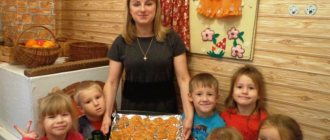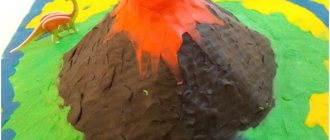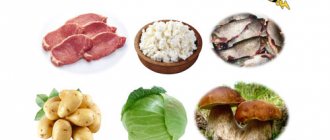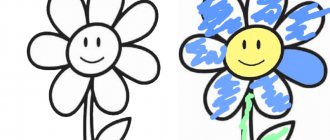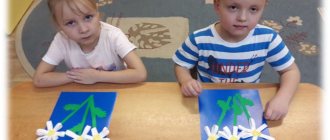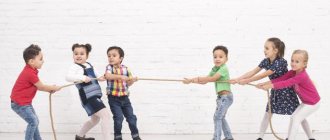Lesson “About volcanoes” for children
Experienced teachers have many ways to instill in a preschooler a love of science. These include working in a “children’s laboratory”, conducting scientific experiments, and simple experiments. By independently experimenting with substances and observing physical phenomena, children not only acquire knowledge about the world around them. They learn to think outside the box, exploratively, and can sometimes surprise with their logic.
One of the interesting topics about nature for children is volcanoes. The amazing world of these natural phenomena will not leave any child indifferent. And practical experience under the guidance of a teacher will delight even the most passive students.
Audience: preschoolers 5-6 years old
Props:
- Slides or posters about the structure of volcanoes, books about volcanoes for children, drawing sheets, pencils, markers, paints, brushes.
- Kit for conducting the experiment (basin or deep bowl, jar or bottle, water, cardboard, tape, soda, vinegar, dishwashing detergent, food coloring).
Progress of the lesson
The teacher begins the lesson with a riddle about a volcano:
-I throw stones, lava,
I am a dangerous giant!
Famous for its bad reputation.
What's my name? (Volcano)
- Children, today we will learn a lot of interesting things about volcanoes, what they are made of, how they sleep, erupt, and change the nature around them. In our laboratory we will conduct a magical experiment and see how lava flows out of a volcano, and at the end of the lesson we will have a quiz with questions about volcanoes. Do you love experiments and quizzes? At the end of the lesson, we will also play the game “Volcanologists”.
— What is a volcano? Maybe someone already knows?
This is a large natural mountain with a hole at the top from which hot streams pour out onto the surface of the earth.
— Where did the name Vulcan come from? The ancient people - the Romans - had a God of fire named Vulcan and he lived on the island of Vulcano in a country that is now called Italy. The god Vulcan commanded fire and lightning, and helped blacksmiths use fire to make objects from iron.
Here the teacher draws the attention of preschoolers to slides or posters about the structure of volcanoes.
—What does a volcano consist of? You and I already know that a volcano is a big mountain. It has a hole - a vent, from which hot, red-hot rock - lava - flows. The top of the vent is called a crater. It is located at the very top of the mountain. And below the mountain-volcano there is a huge cave with a hot substance called magma.
— Why do volcanoes erupt? Magma accumulates in the cave, begins to boil, rises up the vent and pours out onto the ground through the crater, turning into lava. Along with the magma, columns of smoke and volcanic ash erupt from the volcano, and hot stones fly. The whole earth around becomes gray and lifeless.
Physical exercise “Volcanic eruption”
- Let's imagine how a volcano erupts! Let's all sit on our haunches or on the floor. We are magma in an underground cave. Now let's start boiling and seething. We will splash our hands in the air and try to jump up. So the volcano is trembling, preparing to erupt. Now let our volcano burst out through the vent. Children jump up and raise their hands up. Magma poured out of the vent through the crater and spread over the ground, becoming lava.
Interesting facts about volcanoes
— And now interesting facts about volcanoes . They are active and dormant (extinct). Active volcanoes are those that have erupted in the last 10 thousand years and may still wake up and spew lava. Sleeping volcanoes will never wake up again. All volcanoes are studied by scientists - volcanologists; they are the ones who make predictions about what will happen next, whether the volcano will erupt or go dormant.
— The largest volcano on the planet, if you count the height from sea level, is Ojos del Salado . Its height is 6887 meters. It is located in South America and is considered dormant and extinct.
— The most dangerous volcano is located in Mexico, it is called Popocatepetl . Can you repeat this word? Volcanologists expect that he will someday wake up and erupt lava. Popocatepetl can kill a lot of people.
— In the Canary Islands there is a volcano on which a restaurant was built, and people cook food right on the fire of the volcano! They grill shish kebab and fish and treat the guests!
Now let's try to make a volcano erupt ourselves!
Children's laboratory experience
The teacher makes a model of the volcano in advance of the lesson or during the lesson with the children.
A basin or tray is placed on the table. This will be an island. The cardboard must be rolled into a cone and the seam sealed with tape or glue. The tip of the cone - cut off the crater with scissors. The cone can be coated with plasticine, so it will look like a real volcano. Place a bottle at the bottom of the basin under the cone, pour a tablespoon of soda into it, and pour in dishwashing detergent (25 ml). You can pour pebbles, sand into a basin around the mountain, and place animal figures. This way the picture will be more realistic.
In a mug, dilute food coloring (can be red or orange) with water and pour everything into a bottle under the volcano with the other ingredients. This way the magma will be ready.
And now the most important thing: pour vinegar into the mouth of the volcano and watch the eruption!
Here the teacher needs to be careful, it is important not to spill the vinegar and not allow the children to inhale this liquid.
Mixed with baking soda and dish soap in a bottle at the base of the volcano, the vinegar will create a rich foam from the volcano that will flow down the mountainside.
If you add baking soda and vinegar, the volcanic eruption can be repeated several times. Children will undoubtedly enjoy the spectacular experience.
After the experiment, it is advisable to ventilate the room.
Quiz
The quiz will help little researchers consolidate their acquired knowledge. Questions:
— Where did the name “volcano” come from?
— Which artisans did the god of fire help?
— What is the name of the hot substance in the cave under the volcano?
— What is the name of the long hole in a volcano through which magma rises?
- What is a crater?
— What does the magma that flows from the crater of a volcano turn into?
— What types of volcanoes are there?
—Who are volcanologists?
— What is the name of the largest volcano on the planet? Such a difficult word...
— What is the name of the most dangerous volcano?
Game "Volcanologists"
The most active participants in the quiz can be nominated as scientists - volcanologists. Let it be a girl and a boy.
Now you need to choose 3 - 4 strong boys who will firmly hold hands and form the mouth of a volcano. Their task is to hold their hands no matter what and not break the circle.
Volcanologists need to fill the volcano with magma. To do this, they call the rest of the participants into the mouth. A girl - a volcanologist - takes other girls by the hands and leads them into a circle - the mouth of a volcano. And the boy, a volcanologist, brings the boys, “pushing” them into the crater.
Circle - the muzzle stands firmly, without unclenching his hands. Children will have a lot of fun climbing into the circle and crowding around there; at this time the volcano is already seething, preparing to explode.
Everyone who did not fit into the crater can be called dinosaurs; they wander around the volcano. As soon as the vent overflowed, everyone who could entered the circle, the magma tore the vent - the volcano erupted, the children jumped out or fell out of the circle onto the floor. It's so fun!
Maybe now volcanologists themselves will choose an assistant and be the vent?
At the end of the lesson, the teacher invites the children to look at books about volcanoes for children with illustrations. Based on the knowledge they have acquired, children can themselves draw a volcano and the process of its eruption, using sheets of paper, paints, felt-tip pens, and pencils.
So, from the drawings in kindergarten, you will get an almost real scientific and educational exhibition about volcanoes for children.
Corrective effects of fairy tales
The fairy tale “Sandy Volcano” examines two opposing models of behavior of mom and dad in a situation when their child shows greed: encouragement and, conversely, teaching the child to interact with others.
Unfortunately, some parents are not alarmed by their child's greed. Moreover, some of them even encourage this behavior, believing that the baby values his goodness. In the fairy tale, this model of parental behavior is illustrated by the example of Mama-be-gemotikha, who considers her son to be thrifty, praises him and thereby encourages greed in him. But in fact, frugality has nothing to do with it. Seva the hippo does not take care of her things and does not value them. And this is not surprising - when a child receives things for nothing, the more they appear, the less he values them. So, a brand new toy may be broken after five minutes, and candy may be thrown away half-eaten. In fact, Seva’s behavior is driven by the desire to prevent someone else from taking possession of things. Because of this, he finds himself isolated - he has no friends at all. Having learned about this, Papa Hippo is very surprised. He decides to watch his son play with other animals himself. Hippo Dad understands that Hippo needs to be taught how to interact with others. He organizes the game “Sand Volcano” to unite Hippo and other animals. Hippo Dad teaches his son to share and cooperate with others. Through the metaphor of water droplets joining together, it demonstrates how important friendship is to achieving a common goal. At the end of the story, Mother Hippo notices that by communicating with others, her son becomes happier. She changes her attitude towards her son’s “frugality” and supports his desire to share the apple with Piglet. Mosina E.S. Why do clouds turn into clouds? Fairytale therapy for children and parents. - M.: Genesis, 2012. P. 87-93. Read other therapeutic tales Fairytale therapy for children
Volcano that is taller than Everest
Volcanoes are found not only on land, but also on the ocean floor. Sometimes their tops come to the surface, and volcanic islands are formed. The Hawaiian Islands in the Pacific Ocean are just one of them. The volcanoes Mauna Loa and Kilauea are active, and Mauna Kea is extinct. Their height above the water surface is about 4 kilometers. But they rise many kilometers above their underwater base. Therefore, the highest volcano in terms of relative altitude, Mauna Kea (about 10,000 m), has an altitude greater than the highest land mountain, Everest (8848 m).
How does an eruption occur?
A typical volcano is a hill with a pipe running through it, called vent . This vent rises from a magma chamber . lava - rushes up the vent and is thrown into the air . This phenomenon is called a volcanic eruption . Sometimes, along with an eruption, rain falls, which, mixed with ash, turns into rivers of mud. Lava melts rocks and destroys all living things, and after the eruption it hardens into a hard crust. As these solid layers accumulate, the volcano grows. But a volcanic eruption is not always accompanied by a lava flow; sometimes it can be done without it.
Mount Kilimanjaro is the highest point in Africa. This snow-capped, extinct volcano stands out from the surrounding lowland savannahs.
Types of volcanoes
Based on their activity, volcanoes are divided into 3 groups: active, dormant, and extinct.
- Active volcanoes are those that are currently erupting. If magma does not pour out, and the volcano smokes, then it is also considered active.
- Volcanoes that have retained their shape and in whose depths weak tremors and earthquakes periodically occur are considered dormant
- Extinct volcanoes include those that were active once in the distant past, and their cones have been destroyed .
Volcanoes have different shapes, depending on the nature of the eruption and the type of volcanic material.
- Central volcanoes are formed due to vent cracks that arise in places where the earth's crust breaks. On the sides of the cracks there is accumulated volcanic material.
- Stratovolcanoes have a regular cone shape, formed by layers of lava and clastic rocks.
- Shield volcanoes of the central type originate in cracks and fracture sites of lithospheric plates. In this case, magma rises through cracks in the earth’s crust, spreads like lava over the surface and hardens, forming lava covers for tens of kilometers.
The most famous volcanoes
Krakatoa (Indonesia) - 813 m, active
Fuji (Honshu Island, Japan) - 3776 m, extinct
Elbrus (Caucasus) - 5595 m, has two peaks
Vesuvius (coast of the Gulf of Naples, Italy) - 1281 m, active
Etna (Sicily) - 3290 m, one of the most active in Europe
Largest eruptions
The eruption of Mount Tambora , located on the Indonesian island of Sumbawa, which occurred in 1815, is considered the most powerful in human history. The explosion of the volcano was heard on the island of Sumatra, that is, 2 thousand km from Tambora! More than 70 thousand people died because of this disaster.
The newly rebuilt city of Saint-Pierre next to the active volcano Mont Pelée in Martinique
Mont Pelee volcano , located in the northern part of the island of Martinique, suddenly woke up on the morning of May 8, 1902 and covered the nearby city of Saint-Pierre with a hot cloud of pellet and gas. As a result of the eruption, about 30 thousand people died.
Volcano Nevado del Ruiz , located in Colombia, has repeatedly presented residents of nearby settlements with unpleasant surprises in the form of eruptions. However, on November 13, 1985, the volcano raged in earnest. It produced a powerful emission of burning rocks, which melted glaciers and caused mud flows. They, in turn, destroyed the city of Armero, which stood 46 km from the source of the eruption. As a result of the disaster, about 25 thousand people died.
Ruins of the city of Pompeii. Almost all the inhabitants of the cities of Pompeii and Herculaneum died as a result of the terrible eruption of Mount Vesuvius, which occurred on August 24, 79 AD. e.
Which volcano should you be most afraid of right now?
The most dangerous volcano on our planet is the Cumbre Vieja , located on the Canary island of San Miguel de la Palma. Volcanologists claim that if this volcano “wakes up”, its huge slope will immediately collapse and collapse into the Atlantic Ocean, where it will cause a colossal wave to appear (its height, according to experts, will be 900 m, and its speed will be about 800 km/h). The wave will head towards North and South America, simultaneously hitting Africa, southern England, and the Caribbean islands. Scientists believe that as a result of such a tsunami, New York, Miami, Boston and Washington will be wiped off the face of the earth. By the way, some experts suggested simply destroying the volcano without waiting for it to “awaken,” but there is still no equipment that can do this “painlessly.”
In total, there are about 4 thousand volcanoes on the globe, of which about 1340 are potentially active.
Yellowstone Caldera
The structure of the Yellowstone caldera
The Yellowstone Caldera is one of the largest known volcanoes in the world, and it is not just one volcano, but an entire system. It is located in North America. Calderas are large, crater-like basins formed after the collapse of the top of a long-dormant or extinct volcano. The size of the giant Yellowstone caldera is about 55x72 km. The first powerful eruption of the supervolcano occurred 2.1 million years ago, then 1.3 million and 640,000 years ago. Now there are from 1 to 20 earthquakes a day, but they are very weak - with a magnitude of no more than 3 points.
All that is needed
For the experiment you will need some household chemicals and decorative elements to create an island. The volcano island can be made from natural materials or use dinosaur sensory box sets.
A model of a volcano is made from plasticine. Creating a fabulous volcanic island for the experience is the main component of it and serves to develop the child's imagination and creativity. Such activities will help instill a love for chemistry and geography. The child will develop fine motor skills of the fingers while making plasticine terrain and its inhabitants.
To make an island you need:
- cardboard;
- stapler or narrow tape;
- box with colored plasticine;
- small animal toys;
- colorful pebbles;
- a large plastic box or bowl in which the island will stand;
- glass or plastic container with a volume of 200 ml for the volcano crater.
To conduct the experiment you will need:
- soda 20 g;
- food coloring:
- vinegar 9%;
- dish detergent 25 ml;
- water 100 ml.
Usually the experiment continues until mom runs out of all the baking soda and vinegar, so be patient.
Children cannot carry out the experiment on their own without adults. If vinegar gets into a child's eyes or mouth, it can cause a burn to the mucous membranes, and if swallowed, it can cause a burn to the esophagus.
Geysers
Hot springs often appear around volcanoes, even long-dormant ones. If there is a cavity underground where underground water accumulates and heats up, a geyser is formed - a source that periodically releases fountains of hot water and steam. Pressurized water in underground voids gradually heats up above 100 °C. When it reaches a critical temperature, it boils. The resulting steam noisily ejects from the geyser, carrying boiling water with it.
In Yellowstone Park in the USA there is Lolina geysers, in which there are more than 3000 of them. The famous Vieux Fidel geyser throws out a hot water column 50 m high almost every hour. And the Giant geyser gushes for 7 minutes at different intervals and reaches a height of 61 m.
Share link
